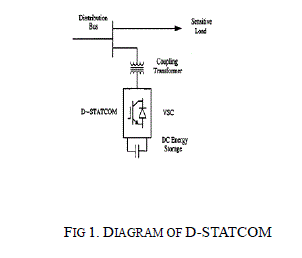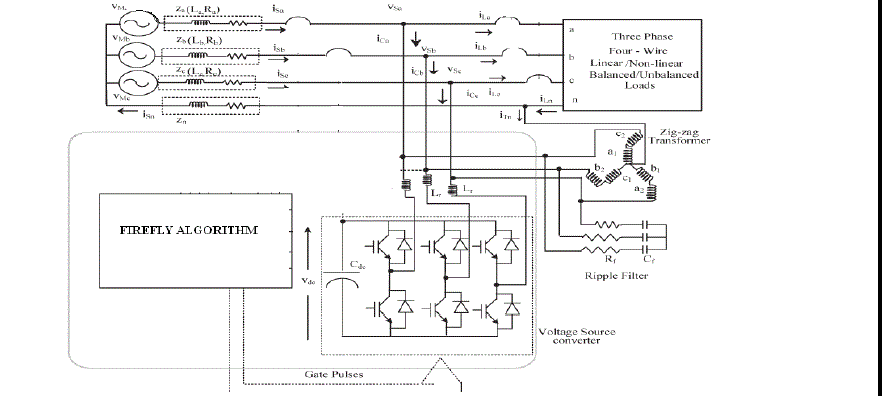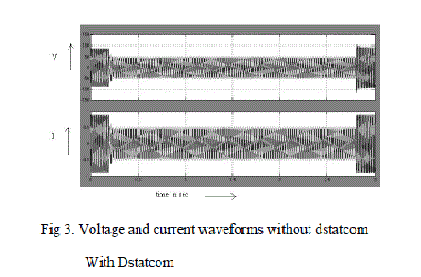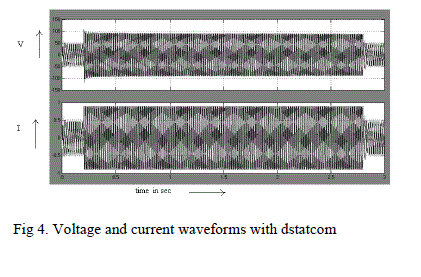Index Terms
|
| FIREFLY algorithm, DSTATCOM, Voltage source converter, zig-zag transformer |
INTRODUCTION
|
| The power quality problems in the ac distribution systems are mainly due to the proliferation of different types of nonlinear loads, unplanned expansion of the distribution system etc. These power quality problems include high reactive power burden, harmonic currents, load unbalance and excessive neutral current. The power quality at the point of common coupling (PCC) is regulated by the various standards such as IEEE-519 standard. A Three-phase fourwire distribution static compensator (DSTATCOM) is used for neutral current compensation along with voltage regulation or power factor correction, harmonic elimination and load balancing in a three-phase four-wire system with linear and non-linear loads .There are some topologies reported in the literature for three-phase four-wire DSTATCOM such as a VSC (Voltage Source Converter) with four leg , three single-phase VSC, three leg VSC with split capacitors and three-leg VSC with a zig-zag transformer. |
| The application of a zig-zag transformer is for compensating the zero- sequence components of the load currents. The application of a zig-zag transformer for reduction of neutral current has an advantage due to passive compensation, ruggedness and less complexity over the active compensation techniques. Therefore, the topology of three-leg VSC with a zig-zag transformer has shown improved performance. |
| There are many theories available for the generation of reference source currents for the control of VSC of DSTATCOM for three phase four wire system in the literature viz. instantaneous reactive power theory (p-q theory), synchronous reference frame theory, power balance theory etc. In this project, a three-phase four-wire DSTATCOM is proposed with a new method control for the voltage regulation at the PCC.A three-leg VSC with a zig-zag transformer is able to perform these compensations required for a three-phase four- wire system. |
| The analysis, simulation, and implementation of a new three-phase four-wire DSTATCOM consisting of a three-leg VSC with a zig-zag transformer controlled with firefly algorithm have been carried out, and its performance has been demonstrated for neutral current elimination along with reactive power compensation, harmonic elimination, and load balancing. |
MITIGATION OF POWER QUALITY PROBLEMS
|
| There are two approaches to the mitigation of power quality problems. The solution to the power quality can be done from customer side or from utility side. First approach is called load conditioning, which ensures that the equipment is less sensitive to power disturbances, allowing the operation even under significant voltage distortion. The other solution is to install line conditioning systems that suppress or counteracts the power system disturbances. A flexible and versatile solution to voltage quality problems is offered by active power filters. Currently they are based on PWM converters and connect to low and medium voltage distribution system in shunt or in series. Series active power filters must operate in conjunction with shunt passive filters in order to compensate load current harmonics. Shunt active power filters operate as a controllable current source and series active power filters operates as a controllable voltage source. Both schemes are implemented preferable with voltage source PWM inverters, with a dc bus having a reactive element such as a capacitor. Active power filters can perform one or more of the functions required to compensate power systems and improving power quality. Their performance also depends on the power rating and the speed of response. Several devices including flywheels, super capacitors, other energy storage systems, constant voltage transformers, noise filters, isolation transformers, transient voltage surge suppressors are used for the mitigation of specific PQ problems. Facts devices like DSTATCOM, and UPQC are capable of mitigating multiple PQ problems associated with utility distribution and the end user appliances. |
USE OF CUSTOM POWER DEVICES TO IMPROVE POWER QUALITY
|
| In order to overcome the problems such as the ones mentioned above, the concept of custom power devices is introduced recently; custom power is a strategy, which is designed primarily to meet the requirements of industrial and commercial customer. The concept of custom power is to use power electronic or static controllers in the medium voltage distribution system aiming to supply reliable and high quality power to sensitive users. Power electronic valves are the basis of those custom power devices such as the static transfer switch, active filters and converter-based devices. Converter based power electronics devices can be divided in to two groups: shunt-connected and series-connected devices. The shunt connected devices is known as the DSTATCOM and the series device is known as the Static Series Compensator (SSC). It has also been reported in literature that both the SSC and DSTATCOM have been used to mitigate the majority the power system disturbances such as voltage dips, sags, flicker unbalance and harmonics. For lower voltage sags, the load voltage magnitude can be corrected by injecting only reactive power into the system. However, for higher voltage sags, injection of active power, in addition to reactive power, is essential to correct the voltage magnitude. |
| The DSTATCOM is capable of generating or absorbing reactive power but the active power injection of the device must be provided by an external energy source or energy storage system. The response time of DSTATCOM is very short and is limited by the power electronics devices. The expected response time is about 25 ms, and which is much less than some of the traditional methods of voltage correction such as tap changing transformers. |
| DSTATCOM |
| The DSTATCOM is a shunt device. It should therefore be able to regulate the voltage of a bus to which it is connected. A distribution static compensator (DSTATCOM) is a voltage source inverter (VS1)-based power electronic device. Usually, this device is supported by short-term energy stored in a DC capacitor. When a DSTATCOM is associated with a particular load, it can inject compensating current so that the total demand meets the specifications for utility connection. Alternatively, it can also clean up the voltage of a utility bus from any unbalance and harmonic distortion. |
 |
PROPOSED THREE-PHASE FOUR-WIRE DSTATCOM
|
| The three-phase four-wire DSTATCOM is used for reactive power and harmonics currents compensation along with load balancing and neutral current compensation. The power circuit of proposed three -leg VSC based DSTATCOM with zig-zag transformers. The linear and non-linear, balanced and unbalanced loads are connected at the PCC. The transformer connected in zig-zag at the PCC provides a path for zero sequence harmonics and fundamental neutral currents The VSC consists of six insulated-gate bipolar transistors (IGBTs), three interface inductors, and one dc capacitor. The DSTATCOM can be operated for power factor correction at the supply side or to regulate the voltage at the PCC to the reference value. |
| The source current is in phase with the voltage, when it is operated in the power factor correction mode, but the voltage at PCC is not regulated. In the voltage regulation mode, DSTATCOM injects a current such that the voltage at PCC (VS) and source voltage (VM) are equal in magnitude. |
 |
FIREFLY ALGORITHM
|
| Most of the nature inspired algorithms are metaheuristic. Heuristics are problem specific and are not efficient at solving others, whereas metaheuristics are indented to solve a wide range of problems. Meta heuristics might not be as efficient as problem specific heuristics; they can easily replace heuristics when they are not readily available. Every algorithm defined thus far has its own way of working out solutions to diverse problems. There might be some performance differences but all algorithms work towards establishing the goal. Every algorithm specializes at solving a certain issue, for example Ant Colony Optimization specializes at scheduling, assignment and routing problems and may lack the performance advantage when applied to solving multi-objective function, which is Particle Swarm Optimizations forte. The firefly algorithm is a metaheuristic algorithm, which is inspired by the flashing behavior used by fireflies to attract each other in the mating process. The brightness of the firefly is the key point of the algorithm, and is equivalent to the objective function under consideration. Three main assumptions were made when proposing the algorithm: |
| i) All fireflies are unisexual that is one firefly will be attracted by all others. |
| ii) Attraction is dependent on the amount of brightness, that is a less brighter firefly is attracted to a brighter one. |
| iii) The brightness of the firefly is equivalent to the objective function. |
| The attractiveness is dependent on the distance between the two fireflies as the intensity of light decreases as the distance between the two fireflies increases. Therefore, the closer the fireflies the more attractive they seem to each other. Multiple variants of firefly algorithm are being developed.The firefly algorithm has been proved to be efficient at solving optimization tasks and can be more efficient than other meta-heuristic algorithms when applied to continuous constrained optimization tasks, stochastic functions, multi-modal functions and even in the field of digital image processing.Given the wide range of applications,less complexity and more efficiency than other meta-heuristic make the firefly algorithm a good subject for continuing research. |
| Flashing behavior of the fireflies is unique to the kind of species they belong to and varies from one type of species to the other. The aim of such flashing behavior can be either of attracting mates or for attracting prey. The flashing light can be formulated to mimic the objective function under consideration and formulate a new optimization algorithm. |
| The optimization process depends on the brightness of the fireflies and the movement of fireflies towards their brighter counterparts. Every firefly is attracted to the other depending on brightness because the fireflies are all unisexual according to the first assumption about artificial fireflies. The following section describes the pseudo code |
| i. Define an initialize benchmark function f(x), x = (x1, ..., xd) |
| ii. Generate initial population of fireflies xi (i = 1, 2, ..., n) |
| iii. Determine light intensity for xi by calculating f(xi) |
| iv. Define light absorption coefficient γ |
| While t < MaximumGeneration |
| Make a copy of the generated firefly population for move function |
| For i = 1 : n all n fireflies |
| For j = 1 : i all n fireflies |
| If (Ij > Ii ), |
| Move fireflies i and j according to attractiveness |
| Evaluating new solutions and updating light intensity for next iteration |
| End if |
| End for j |
| End for i |
| Sorting the fireflies to find the present best |
| End while |
| Begin post process on best results obtained |
| During the iterative process, the brightness of one firefly is compared with the others in the swarm and the difference in the brightness triggers the movement. The distance travelled depends on the attractiveness between the fireflies. During the iterative process the best solution thus far is continuously updated and the process goes on until certain stopping conditions are satisfied. After the iterative process comes to a halt the best solution of the evaluation is determined and the post process is initiated to obtain the results. |
MATLAB BASED MODELLING OF THE SYSTEM
|
| The three-leg VSC and the zig-zag transformer based DSTATCOM for a three-phase four-wire system is modeled and simulated using the MATLAB and its Simulink and Power System Blockset (PSB) toolboxes. The DSTATCOM system is modeled in MATLAB. The ripple filter is connected to the VSC of the DSTATCOM for filtering the ripple in the PCC voltage. The control algorithm for the DSTATCOM is also modeled in MATLAB. The reference source currents are derived from the sensed PCC voltages (vSa, vSb, vSc), load currents(iLa, iLb, iLc) and the dc bus voltage of DSTATCOM (vdc). |
RESULTS AND DISCUSSION
|
| The performance of a three-phase four wire DSTATCOM consisting of a three leg VSC with the zigzag transformer controlled with firefly algorithm. The voltage and current waveforms without DSTATCOM is shown in fig 3 here the expected voltage is 90v due the losses the output voltage obtained is 50v.The voltage and current waveforms with DSTATCOM is shown ig Fig 4 here using facts devices the expected output voltage 90v is obtained. |
 |
 |
CONCLUSION
|
| The analysis, simulation, and implementation of a new three-phase four-wire DSTATCOM consisting of a three-leg VSC with a zig-zag transformer controlled with firefly algorithm have been carried out, and its performance has been demonstrated for neutral current elimination along with reactive power compensation, harmonic elimination, and load balancing. The VSC is controlled using the Ada line-based firfly algorithm estimator. The voltage regulation and power factor correction modes of operation of the DSTATCOM have been observed as expected ones. The dc bus voltage of the DSTATCOM has been regulated to the reference dc bus voltage under wide varying loads. The zig-zag transformer has been found to be effective for compensating the zero-sequence fundamental and harmonic neutral currents.The kilovolt–ampere rating of transformers in the zig-zag configuration is much less compared to that of a similar star–delta transformer. It has been found that the control technique is simple to implement, is fast in response, and gives nearly zero phase shift in the estimated reference currents. |
References
|
- Bhim Singh, Vishal Verma and Jitendra Solanki,“Neural networkbased selective compensation current quality problems in distribution system,” IEEE Tran on Industrial electronics, vol. 54, no. 1, pp. 53 –60, Feb. 2007.
- J.C.Montano, P.SalmeronRevuelta,“Strategies of Instantaneous Compensation for Three-Phase Four-Wire Circuits,”IEEE Power Engineering Review, vol. 22, no. 6, pp. 63 - 63, June 2002.
- Hurng- LiahngJou, Jinn- Chang Wu, Kuen- Der Wu, Wen- Jung Chiang and Yi- Hsun Chen, “Analysis of zig-zag Transformer applying in the three-phase Four- Wire Distribution Power System,” IEEE Trans. on Power Delivery, vol. 20, no. 2, pp. 1168- 1173, April 2005.
- Hurng-Liahng, Kuen- Der Wu, Jinn- Chang Wu and Wen- Jung Chiang, “A three-phase four- wire power filter comprising a three-phase three-wire active filter and a zig-zag transformer,” IEEE Trans. of Power Electronics, vol. 23, no. 1, pp. 252- 259, January 2008.
- H. Akagi, E H Watanabe and M Aredes, Instantaneous power theory and applications to power conditioning, John Wiley & Sons, New Jersey, USA, 2007.
- K.R.Padiyar, FACTS Controllers in Transmission and Distribution, New Age International, New Delhi, 2007.
|